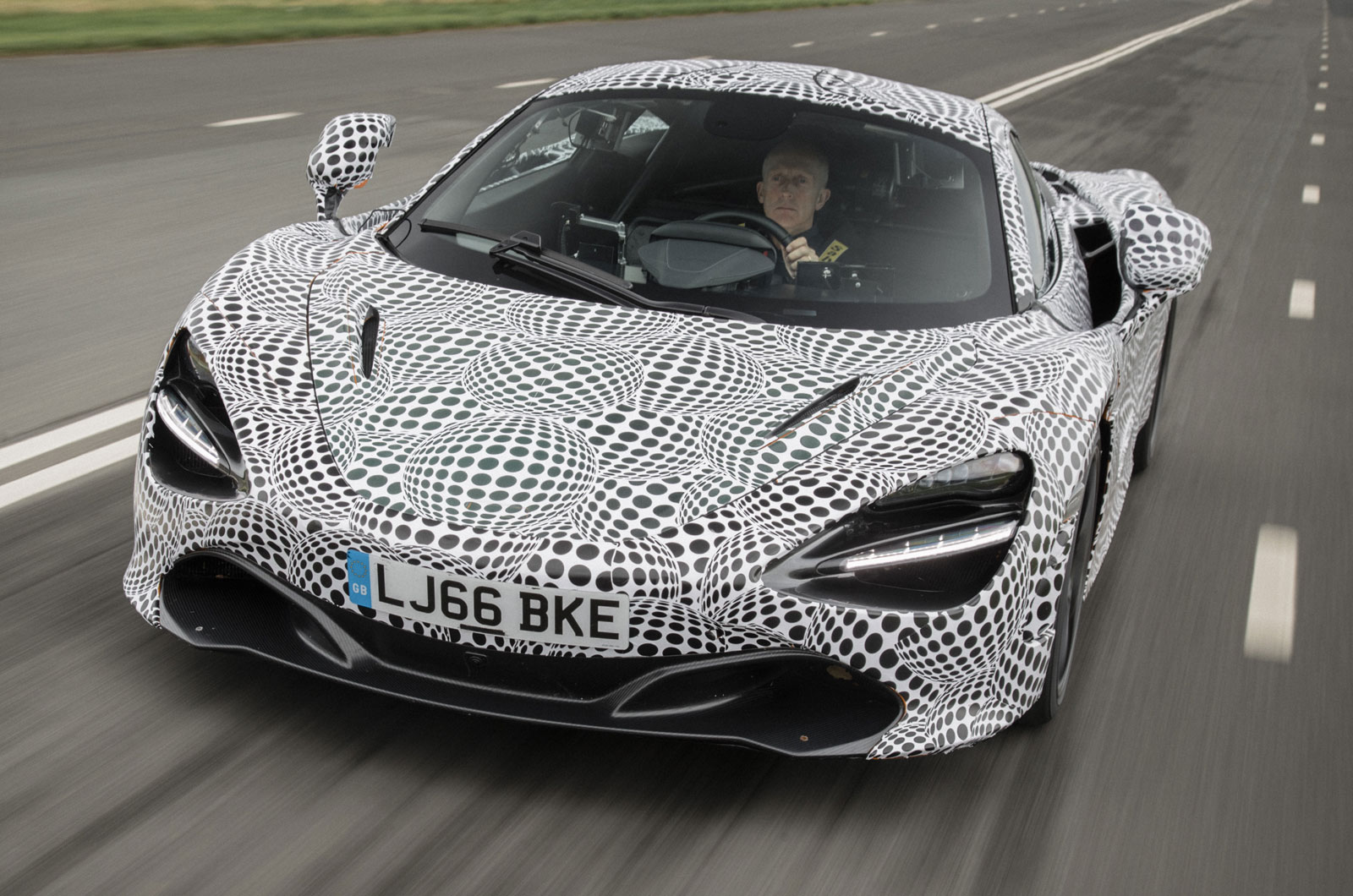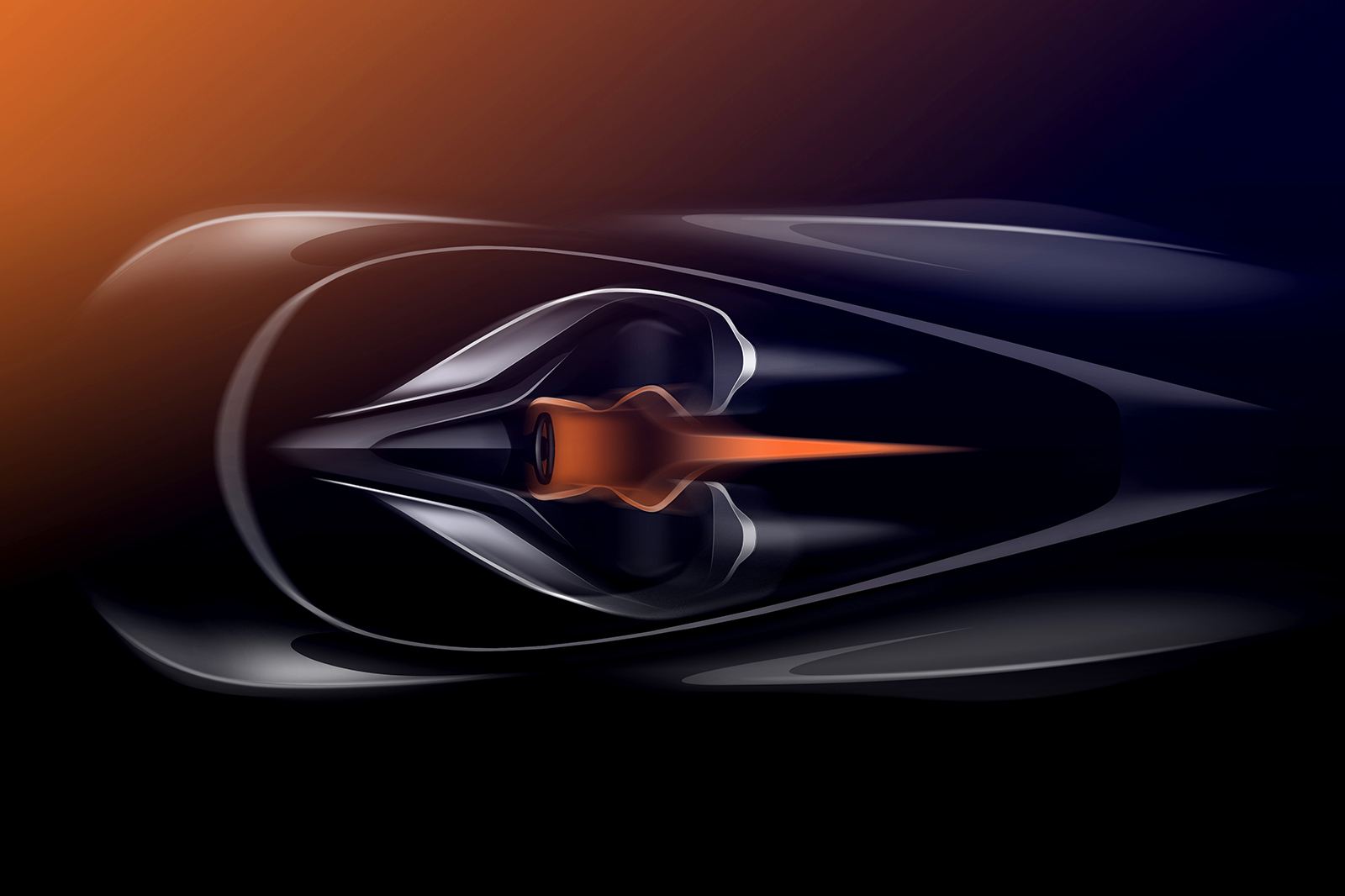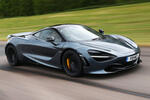McLaren has confirmed how its forthcoming three-seat hypercar, codenamed ‘BP23’, will be the fastest McLaren ever made by having a top speed of more than 243mph, at which point “it will still be accelerating”. The car will be revealed before the end of the year.
In 1998, the previous three-seat McLaren, the F1, became the world’s fastest production car when Le Mans winner (and now Bugatti test driver) Andy Wallace took the F1 along Volkswagen’s Ehra-Lessien test track, in Germany, at 242mph, exceeding the 231mph the F1 managed in 1993 at the Nardo high-speed bowl in Italy.
The modified 720S (pictured) is the development mule for the three-seat BP23 (standing for bespoke project two, three-seater), the power of which will far outdo the F1’s 627bhp. McLaren’s ultimate series chief Andy Palmer (not that one) says the BP23’s advanced aerodynamics will “really move things on from an acceleration perspective too”. Just 106 BP23s will be built when the car goes on sale in 2019, but McLaren is keen to stress that its focus won’t be on the track. Like the track-friendly Senna Ultimate Series model, however, it'll shun McLaren's traditional alphanumeric designations for a full name.

“It’s very powerful, more powerful than the (986bhp) P1 GTR,” McLaren CEO Mike Flewitt told Autocar at the Geneva motor show. He also confirmed the car was “a long way” down the road for development, with a centre-seat mule in testing for several months, which is “easier to get into than an F1” and which “feels very natural” when you drive it. The BP23 will have a hybrid powertrain to augment the power of its twin-turbocharged V8 engine to vast levels, and it also needs significant changes to its carbonfibre passenger cell – which Palmer will only describe as “different” to the 720S’s – to comfortably accommodate three occupants.
Those power levels and the predicted high speeds, though, don’t come without complications. Andy Palmer admits McLaren is “pretty much at the limit of what tyres, as well as other systems, can do”. The realities of running consistently at speeds approaching – or perhaps beyond – 250mph are a significant step onwards again from 200mph from a tyre, energy and aerodynamic perspective. Palmer revealed previously that the goal of this car is "to give customers the ability to have a high level of luxury, bespoke elements on the car, high performance, high speed – a very much road-focused grand tourer".
“The centre seat is an amazing thing,” Palmer told Autocar. “The attraction is not only the driving position, but you can take two passengers and luggage on a long journey. I’ve been sitting in the back and it’s not a bad place to be.

“Technology has moved on, particularly in carbon, and in our tub and monocell, and how we engineer that to accommodate three seats. It’s not without compromise, it’s not sitting in the back of a Mercedes S-Class, but it’s not a huddled or tight space.” Palmer and his colleagues say that entry and egress to the BP23 is far easier than it was in the F1, too. Cameras might augment mirrors to increase visibility without compromising aerodynamics.
Another of McLaren’s headaches, though, is deciding where to complete the BP23’s high speed runs, which have already been planned into the development process. Using VW’s Ehra-Lessien test track – which has a five mile main straight which you can enter off a curved bend at an easy triple figure speed – is out of the question 20 years on from the F1, given VW has competing brands and it’s where the Bugatti Chiron will eventually prove its top speed.
High speed test track ‘bowls’, meanwhile, even like the one at Nardo that scrubbed 10mph from the F1’s pace, prevent cars of the BP23’s potential from reaching their top speed. Palmer says he “would like to run on Tarmac”, but beyond some of the world’s longest runways, or some road race events where the safety of drivers becomes an issue should anything go wrong, McLaren might even have to look to salt flats like those at Bonneville. Even there, though, tyres become an issue, because of the lower grip levels. And while Bugatti can use Ehra-Lessien for customer events, McLaren will have to think where its 106 BP23 buyers can experience close to their car’s full potential.

The rebirth of a three-seat McLaren originated with a single customer request, which McLaren decided could be put into limited-series production. Some 106 cars were confirmed and have all been sold at around £2 million apiece, before visiting McLaren Special Operations for bespoke options. Unlike the Senna or the P1 – which are way more track-biased than the BP23 grand tourer – we’re not expecting a GTR version.
Interestingly, Flewitt said: “It would be fascinating to do a centre seat track car. It would be perfect on a track, and easier to do as you need all sorts of legislation on the road. It’s not planned, or been asked for; we’re not planning one but it’s been thought of. I’m surprised someone hasn’t asked MSO.”
If lap times aren’t the way McLaren will measure the BP23’s performance (and they’re not), that leaves acceleration or top speed as the two measures by which the BP23 will be the fastest-ever McLaren. Palmer won’t be drawn on power outputs or even powertrain specifics, a highly boosted development of the 720S’s 4.0-litre V8 engine is expected, supplemented by a hybrid system whose primary mission will be to eliminate turbo lag.
Read more
McLaren F1 to be reborn as ‘hyper-GT’
McLaren hyper-GT to be more powerful than P1
McLaren to usher in new breed of hybrid and autonomous cars
Extreme 814bhp McLaren Senna GTR concept revealed
McLaren Senna: exclusive new pictures of 789bhp hypercar testing
McLaren 720S

This is gonna be phenomenal !!!!! Should have a V12 though
That is exceptionally welcome.
McLaren's task now is to make this look as coherent and distinctive as the original F1 of 1992, which, being 1/4 century old !!!, remains aesthetically far superior to any subsequent McLaren.
One good thing about McLarens is that they are relatively compact, unlike 'the bigger the better' attitude of hypercars like the bloated Avantador and worst the Mercedes SLS
It needs a NA V12 of course.
Just the thing for road use on the roads of the UK in 2017!
Get real.
Just the thing for road use on the roads of the UK in 2017!
Get real.
It would be an unbelievable achievement for McLaren to get that car all sorted and delivered to customers in the next 92 days! ;)
"but beating the F1’s 240mph top speed or the P1’s acceleration figures (0-62mph in 2.8sec and 0-186mph in 16.5sec) would require an output beyond even the P1’s 903bhp". If the much less powerful 720S is already as fast as a P1, then unless top speed is a priority, perhaps similar power to the P1 might be ample enough for the BP23 to allow it some daylight between it and the 720S if it uses some of the 720S's trickery. It still amazes me that McLaren's supercar matches their much more expensive, much more exotic and much more powerful hypercar after only a few years!
Today's obsession with high-speed grip and therefore downforce, must extract a considerable aerodynamic drag penaltic penalty, considering the F1 acheived 240mph with just 627bhp whilst the new car, in order to exceed the F1's maximum, is expected to need more than 903bhp. Where is the progress?
Today's obsession with high-speed grip and therefore downforce, must extract a considerable aerodynamic drag penaltic penalty, considering the F1 acheived 240mph with just 627bhp whilst the new car, in order to exceed the F1's maximum, is expected to need more than 903bhp. Where is the progress?
The Veyron had to have 50% more bhp than the F1 just to go an extra 10mph or so faster, although I suspect that power was needed to overcome its hefty weight rather than the effects of drag. Bar the Koenigsegg CC8, I'm struggling to think of any other road car that has/had around 627bhp but came even remotely close to the F1's top speed. With the focus nowadays seemingly on lap times, and acceleration up to 150-200mph, the days of slippery road cars are almost a thing of the past. A F1 would probably get spanked around most circuits by current circa 627bhp car.
My oh my.. Not track focused must mean focusing on straightline speed and comfort one would suppose. 0-186 mph in 13 s would count as an improvement. And yes i doubt the big mac would be completely slow couch on track. Who knows perhaps even faster than a GT 2 RS at the Nürnberg?
Source : autocar

